It’s something that gets repeated a lot: Everyone should include more fish in their diet, and on a more regular basis. It has a lot going for it, after all — it’s low in the bad stuff like fat, and high in the good stuff like protein, omega-3 fatty acids, and minerals like iron, iodine, and potassium.
The Washington State Department of Health says a diet high in fish has been linked to things like lowering blood pressure, reducing inflammation, relieving the pain of arthritis, and even reducing the risk of things like stroke and a heart attack.
Current recommendations from organizations like the American Heart Association suggest that ideally, everyone should try to work fish into their meals at least twice a week, and let’s be honest — that can be tough. The prospect of fish twice a week is unlikely to be met with the same excitement there would be if it was, say, pizza. And for some people, eating fish at all can be a tough sell. So, let’s talk about some ways to cook fish that will help mix it up, keep dinner from being boring, and — hopefully — even convince the naysayers of the family that they should be looking forward to fish nights, too.
Grilling can be a great way to cook fish in the summer

One of the best things about summertime is digging the grill out of storage, and here’s something to keep in mind: Fish is an excellent choice for throwing on the grill instead of the go-to burgers and dogs.
There are a few things that you need to know before throwing some salmon steaks on the grill, though. According to Healthline, cooking meats and fish over high heat and an open flame have been linked to the formation of a number of compounds that are connected with things like heart disease and diabetes, but there are precautions to take — like making sure you thaw your fish first to shorten the cooking time, and not putting it directly over a flame.
Overcooking is one of the biggest mistakes you can make when cooking fish. Use only a mild (and not overpowering) marinade, leave the skin on for added texture, and move it around as little as possible. Also, make sure your grill grates are clean — a little elbow grease upfront will have serious results later.
Baking is a super-healthy cooking method

Baking is one of the best ways to cook fish. Not only is this the way to help retain all the vital goodness — like omega-3 fatty acids and nutrients — of the fish, but it’s also great for those evenings when you just can’t. Can’t what? Can’t anything. (You know the ones.)
Although specific times and temperatures might vary based on what kind of fish you’re cooking, most fish will bake in under 10 minutes. Seriously — that’s it! That makes this not only a healthy option for getting something tasty on the table, but it’s also great for busy nights when you just don’t want to spend any more time in the kitchen than you have to.
A good rule of thumb is to plan on baking — in a preheated oven — about five minutes for each half-inch of thickness to your fish. You’re also going to want to make sure frozen fish is thawed before popping it in the oven so you’ll get the best texture, and there’s one more brilliant benefit to baking. Wrap your fish in parchment paper or foil and you’ll have minimal dishes to do at the end of the meal. Win!
Broiling is another healthy option
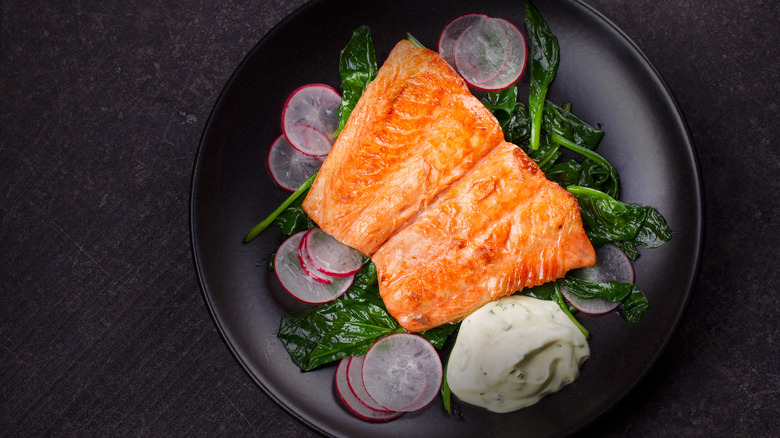
Broiling is a bit like grilling. There are a few major differences, though — the heat source is at the top, and since you can broil fish in your oven, it’s easy to do year-round.
Broiling is generally considered to be one of the healthier ways to cook fish, as there’s no added fat and calories from oils. While you might opt to paint your fish with a dash of oil before popping it in the oven, that’s absolutely not necessary. Choose something like a roasted red pepper or tomato sauce instead, and you’ll avoid oil altogether.
Not all fish is created equal, and some fish are higher in fats than others. The tray in your oven will catch any of the fat that cooks out, and that’s all less fat in your diet. There’s another major bonus here, too! Grilling can be incredibly time-consuming, and sometimes, that’s all right — it’s part of the fun of a hot, summer afternoon, right? But we don’t always have time to spend grilling, and that’s where broiling comes in. Broiled fish usually takes less than 10 minutes — depending on the fish and the size of what you’re cooking — and that’s a time-saver we can all get behind.
Chinese-style steamed makes for a stunning presentation
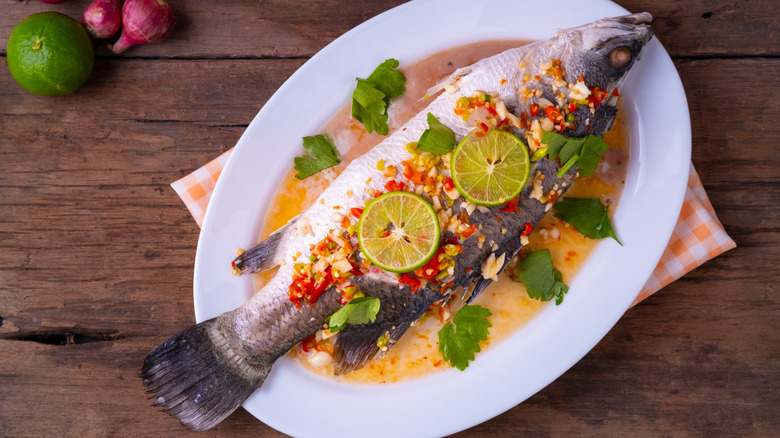
Shutterstock
Chinese-style steamed fish is one of those fancy dishes you might expect to see at a restaurant, not on your own dinner table. But it’s easier to make than you might expect! Essentially, it’s an entire fish — head to tail — that’s been steamed. What’s the benefit? Fans of this cooking method swear that it helps the fish retain all the flavor it was born with — and for fish lovers everywhere, that’s a big deal.
Any white-flesh fish will work for this particular method, but there is a bit of a caveat here: since you’re going to be cooking it whole, this one requires a trip to a fish market, or a grocery store that you know has very fresh, whole fish for sale. It’s key — trying it with frozen fish is just going to result in a texture that’s all wrong, and no one wants questionably textured fish. You’ll also be able to have a fishmonger gut and descale your fish for you, and that’s some work you’ll be glad to hand off to someone else. Choosing aromatics is a fun — and versatile — part, and once the steaming process starts, you’ll have a delicious meal in just about eight minutes.
Oven-smoking your fish will totally up your dinner game

Smoked fish is something you might expect to need to buy pre-smoked if you’re looking to enjoy it, but chef Analiese Gregory told Eater it’s actually much easier than you might expect — and it’s perfectly possible to make some delicious smoked fish right in your own oven.
The trick is all in the preparation — and that’s preparing your oven as well as your fish. Smoking fish works best with fish that’s been cured in a salt mixture, then rinsed and dried. As for the oven, adding a tray of wood chips in the bottom of your oven will simulate the effects of a larger, purpose-built smoker. That’s not just any sort of wood chips, though — you’ll need to get wood that’s meant for use in a smoker, but that also means you’ll be able to choose from varieties — like apple — that are going to add a delicious dimension to your final product.
Poaching is a hugely underrated way to cook fish
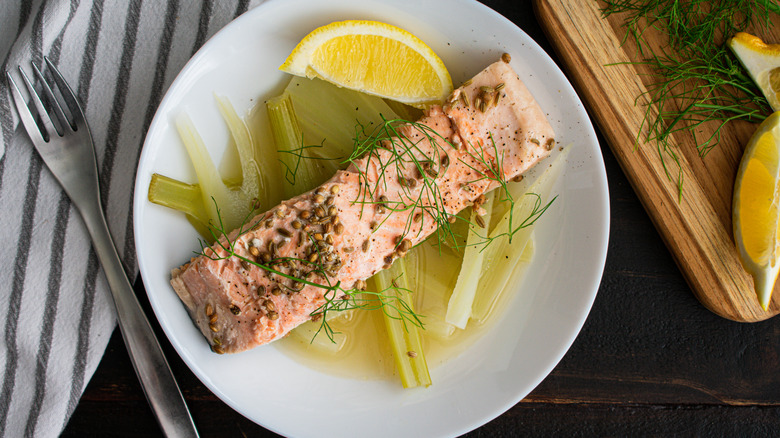
Anyone looking for a quick and easy way to cook fish should also consider poaching. It’s a simple process that’s ideal for lean fish like swordfish and bass, and it’ll take just a few minutes in front of the stove. All you’ll need to do is bring a pot of water up to a temperature of around 140 degrees, and simmer your fish until it starts to turn a little translucent. That should take just around five minutes, and you’re ready to plate.
Poached fish might have a bit of a reputation as being boring, but here are a few tips. Don’t boil the water, as that’s going to leave your fish with a funky texture … and the taste of regret.
Another incredibly valuable tip courtesy of nutrition expert and “The Best 3-Ingredient Cookbook” author Toby Amidor, MS, RD, CDN is that you can add a ton of flavor by poaching in a liquid other than water. Use vegetable broth, wine, or even coconut milk to make poached fish way more interesting. Don’t be afraid to experiment!
Micro-steaming works better than you might think

When it comes to all the gizmos and gadgets in your kitchen, the microwave might seem like the last thing you’d expect to be cooking fish in. Hear us out, though, the microwave is precisely the tool you should be using — for a whole bunch of reasons.
One of the biggest reasons is that steaming fish in your microwave takes just about five minutes, and since fish already comes with a lot of liquids, it’s super easy. Just put your fish on a plate or dish (with whatever seasonings and sauces you like), then cover and let it cook. That’s it!
Another bonus to using your microwave is that it’s also super easy to tell at a glance if the fish is done, or if it needs another minute or two. You can also opt for cooking not just fish this way, but a pile of vegetables, too. Add quick-cooking veggies like green beans to the plate, and the end result is a healthy, delicious meal of fish and veg … right out of the microwave. Who would have thought?
Sous vide can help guarantee perfect fish every time
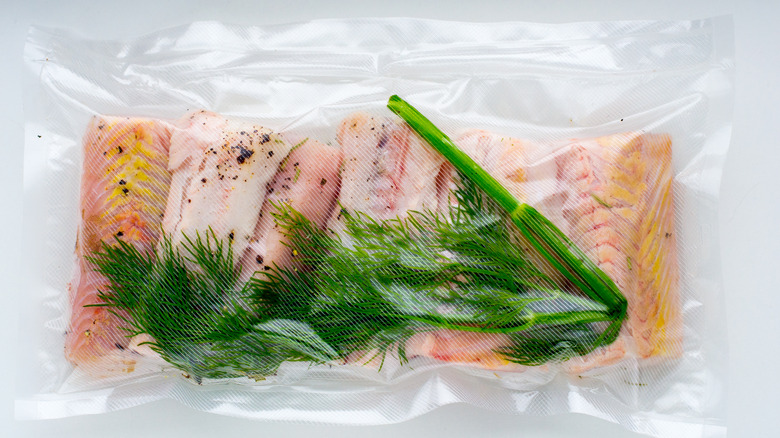
Sous vide is a method of cooking that is wildly popular in restaurants, because it’s easy to guarantee uniform results when cooking multiple dishes, or cooking a particular dish that a place is known for. It’ll come out the same every time, and consistency is incredibly important. It’s a French term that means “under vacuum,” and that’s exactly what’s going on here: food — in this case, fish — is vacuum-sealed then placed in a water bath to cook.
This is a particularly brilliant way to cook fish, because that vacuum-sealed pouch means the fish isn’t going to lose any flavor or juiciness — it’s also not going to come out mushy, and that’s a total win. Seasonings and herbs are added before the pouch is sealed, and while any fish can be cooked sous vide, times will vary. They also recommend that after removing fish from the water bath, 30 seconds in a frying pan will give the outside a much-needed crisp, and the final dish will be next-level.
Frying fish delicious, but not the healthiest option
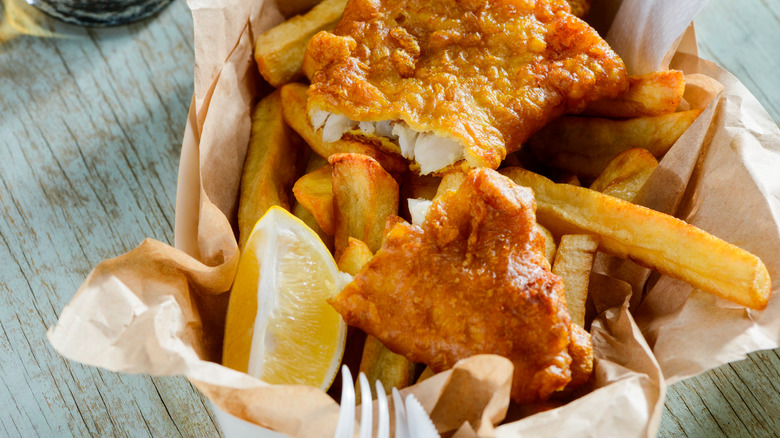
When it comes to taste and texture, arguably the best fish is fried. From the long-time Rust Belt tradition of the fish fry to Britain’s ever-popular fish and chips, frying has been a long time favorite method of cooking.
It might be delicious, but a study published by Natural Medicine Journal has some bad news: It’s definitely not good for you. In fact, they found studies that show eating fried fish once a week was linked to an increased risk of heart failure, and that’s the opposite reason many people try to add more fish to their diet in the first place.
Frying, they say, has been found to decrease the amount of healthy omega-3 fatty acids, and the high temperature of oil that’s used for deep-frying has been found to kick off less-than-healthy compounds that can also cause some serious health issues when eaten regularly. While there are steps you can take to make this not quite as terrible — like skipping the breading that holds in the oil, selecting healthier oils, and pan-frying instead of deep-frying — it turns out that this method is one that you really should skip. Or, at least use sparingly.
Using air fryer is a healthier option for those who love fried fish

Thanks to the relatively recent popularity of air fryers, there’s now another game in town for those who really love their fried fish. Opting to make fish and chips in an air fryer is going to greatly reduce the unhealthy aspects of fried fish. It’ll cut way, way back on all those extra calories and the extra fat that’s usually served up alongside fried fish, and you’ll still get that crispy texture that makes fried fish oh-so-delicious.
Cooking fried fish in an air fryer is super easy, and just requires a simple batter — you can make one from flour, egg, and bread crumbs — along with a bit of seasoning. Start with a 400-degree air fryer, cook for six minutes, flip, then finish it off for another six minutes, and that’s it, you’re done!
Pro tip: Not all fish is created equal when it comes to frying: Thicker, firmer white fish like pollock, cod, and haddock work best for this particular method.
Blackened fish has a texture that’s sure to please

The texture of fish can be a major turn-off for some people, and if that’s the case in your family, blackened might be the way to go. Blackened fish got a serious boost in popularity thanks to the Cajun cooking of chef Paul Prudhomme, and it’s proof that some of the hot trends of the 1980s stand the test of time.
Prudhomme typically used redfish, but the overwhelming popularity of his version meant that redfish was nearly fished to extinction. Now, it’s often used with other types of fish — like tuna, catfish, and tilapia — and they’re still just as good.
The basics are simple: marinate your fish in an oil-and-spice mixture for about 20 minutes, and in the meantime, heat a cast iron pan up to really, really hot. Then, let it get even hotter. Put the fish fillet in the hot skillet (on a thin layer of melted butter), and watch the outside turn black. When it’s the color of the night sky, you’re done — and you’ll have no complaints about mushy fish!
Soused fish is a fun and funky vintage fish dish
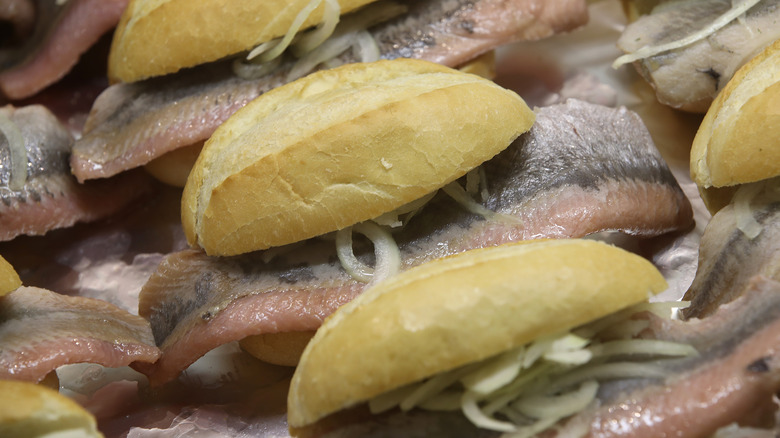
Soused fish was incredibly popular back in ye olde times, and by that, we mean the 1970s. It was a common sight on restaurant menus across Britain, and while you might not see it as widely these days, it’s easy to make at home.
Mackerel is one of the most commonly soused types of fish, and it’s made by simply boiling then simmering a vinegar-based liquid that usually includes things like peppercorns, bay leaves, and even juniper, along with some onion and other veggies. After simmering the liquid to make sure everything’s incorporated, the fish fillets are added and simmered for only around 30 seconds. The entire pot is then removed from the heat, left in the fridge overnight, and served the following day. If you’re looking for something super creative to do with your fish, this just might be the way to go. Soused sandwiches, anyone?
Slow-cooking is the surprising way to get super-moist fish

That’s right, you can absolutely slow-cook fish. The low-and-slow temperature of a slow cooker is almost a foolproof method for making sure fish fillets come out moist, juicy, and still filled with all the nutrients and minerals they’re famed for.
The process is similar to poaching, and it’s basically done by putting just a small amount of liquid in the bottom, setting the fish on something that’s going to keep it out of that liquid — like lemon slices, or on an insert — and letting the fish slowly steam. This method is best suited to thicker pieces of fish — think of salmon that’s around an inch and a half thick — and if you’re doing more than one piece of fish, making sure they’re all the same thickness will go a long way in pleasing everyone at the dinner table. Who would have thought a slow cooker was good for fish, too?
What about reheating fish?
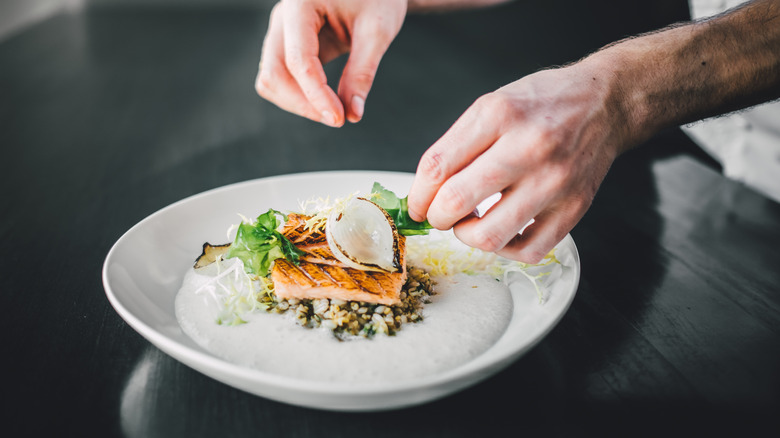
So, you’ve cooked fish the first time, but you have leftovers. For those of us who don’t have a cat who’s just ready, waiting, and willing to help you out with that problem, what’s the other solution? Reheating fish can be a challenge, but cutting down on food waste should be a top priority in every kitchen.
The trick is that you should only be reheating it a tiny bit. Heat your oven to around 400 degrees, but when you take the fish out, don’t put it in the oven — put it on top of the stove. The heat from the oven is going to be enough to bring it up to room temperature safely, and once you’re there, stop. Room temperature fish is going to be much more palatable than dry, hot fish, and don’t knock it until you’ve tried it on a sandwich, or given new life on a bed of fresh rice, polenta, or even grits!
Some tips for cooking stink-free fish
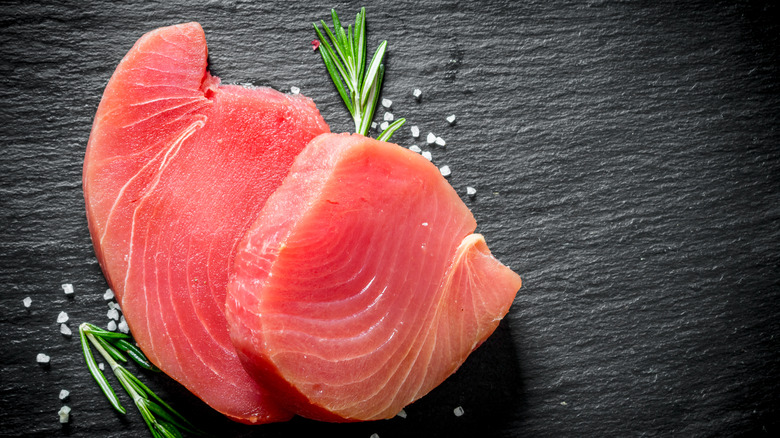
Shutterstock
Now, let’s talk about the elephant in the room: that smell. If you have fish twice a week every week, is your house ever going to not smell like fish? It’s great while it’s cooking, but when you come home from work and step into a fishy-smelling kitchen, that’s less great, right? That’s not even mentioning having a friend over for a post-work drink. Yuck!
There are a few tricks to keeping your house from smelling like an oceanfront wharf. For starters, fresh fish doesn’t have as strong a smell as older fish that’s been frozen — or left to sit in the fridge. You can also soak your fish in milk before cooking, as that’s going to cause a chemical reaction that removes a good bit of the fishy smell.
Wrapping fish in foil will help contain the smell as it’s cooking, and surprisingly, the longer and lower you bake or broil your fish, the less it’s going to smell. Who would have thought, right? Now you know, and now you have no reason not to make fish a part of your weekly meal plan.







